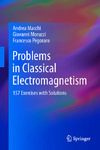| dc.description.abstract | This book comprises 157 problems in classical electromagnetism, originating from
the second-year course given by the authors to the undergraduate students of
physics at the University of Pisa in the years from 2002 to 2017. Our course covers
the basics of classical electromagnetism in a fairly complete way. In the first part,
we present electrostatics and magnetostatics, electric currents, and magnetic
induction, introducing the complete set of Maxwell’s equations. The second part is
devoted to the conservation properties of Maxwell’s equations, the classical theory
of radiation, the relativistic transformation of the fields, and the propagation of
electromagnetic waves in matter or along transmission lines and waveguides.
Typically, the total amount of lectures and exercise classes is about 90 and
45 hours, respectively. Most of the problems of this book were prepared for the
intermediate and final examinations. In an examination test, a student is requested
to solve two or three problems in 3 hours. The more complex problems are presented
and discussed in detail during the classes.
The prerequisite for tackling these problems is having successfully passed the
first year of undergraduate studies in physics, mathematics, or engineering,
acquiring a good knowledge of elementary classical mechanics, linear algebra,
differential calculus for functions of one variable. Obviously, classical electromagnetism
requires differential calculus involving functions of more than one
variable. This, in our undergraduate programme, is taught in parallel courses
of the second year. Typically, however, the basic concepts needed to write down the
Maxwell equations in differential form are introduced and discussed in our electromagnetism
course, in the simplest possible way. Actually, while we do not
require higher mathematical methods as a prerequisite, the electromagnetism course
is probably the place where the students will encounter for the first time topics such
as Fourier series and transform, at least in a heuristic way. | en_US |

